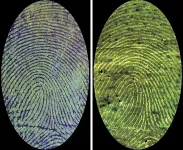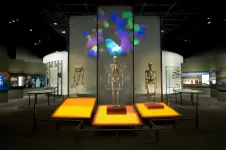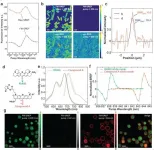Cracking open the mystery of how many bubbles are in a glass of beer
2021-04-21
(Press-News.org) After pouring beer into a glass, streams of little bubbles appear and start to rise, forming a foamy head. As the bubbles burst, the released carbon dioxide gas imparts the beverage's desirable tang. But just how many bubbles are in that drink? By examining various factors, researchers reporting in ACS Omega estimate between 200,000 and nearly 2 million of these tiny spheres can form in a gently poured lager.
Worldwide, beer is one of the most popular alcoholic beverages. Lightly flavored lagers, which are especially well-liked, are produced through a cool fermentation process, converting the sugars in malted grains to alcohol and carbon dioxide. During commercial packaging, more carbonation can be added to get a desired level of fizziness. That's why bottles and cans of beer hiss when opened and release micrometer-wide bubbles when poured into a mug. These bubbles are important sensory elements of beer tasting, similar to sparkling wines, because they transport flavor and scent compounds. The carbonation also can tickle the drinker's nose. Gérard Liger-Belair had previously determined that about 1 million bubbles form in a flute of champagne, but scientists don't know the number created and released by beer before it's flat. So, Liger-Belair and Clara Cilindre wanted to find out.
The researchers first measured the amount of carbon dioxide dissolved in a commercial lager just after pouring it into a tilted glass, such as a server would do to reduce its surface foam. Next, using this value and a standard tasting temperature of 42 F, they calculated that dissolved gas would spontaneously aggregate to form streams of bubbles wherever crevices and cavities in the glass were more than 1.4 μm-wide. Then, high-speed photographs showed that the bubbles grew in volume as they floated to the surface, capturing and transporting additional dissolved gas to the air above the drink. As the remaining gas concentration decreased, the bubbling would eventually cease. The researchers estimated there could be between 200,000 and 2 million bubbles released before a half-pint of lager would go flat. Surprisingly, defects in a glass will influence beer and champagne differently, with more bubbles forming in beer compared with champagne when larger imperfections are present, the researchers say.
INFORMATION:
The authors acknowledge funding from the French National Centre for Scientific Research (CNRS).
The paper is freely available as an ACS AuthorChoice article here.
The American Chemical Society (ACS) is a nonprofit organization chartered by the U.S. Congress. ACS' mission is to advance the broader chemistry enterprise and its practitioners for the benefit of Earth and all its people. The Society is a global leader in promoting excellence in science education and providing access to chemistry-related information and research through its multiple research solutions, peer-reviewed journals, scientific conferences, eBooks and weekly news periodical Chemical & Engineering News. ACS journals are among the most cited, most trusted and most read within the scientific literature; however, ACS itself does not conduct chemical research. As a specialist in scientific information solutions (including SciFinder® and STN®), its CAS division powers global research, discovery and innovation. ACS' main offices are in Washington, D.C., and Columbus, Ohio.
To automatically receive news releases from the American Chemical Society, contact newsroom@acs.org.
Follow us: Twitter | Facebook
ELSE PRESS RELEASES FROM THIS DATE:
2021-04-21
(Boston)--A major obstacle in understanding and treating posttraumatic stress disorder (PTSD) is its clinical and neurobiological heterogeneity. In order to better treat the condition and address this barrier, the field has become increasingly interested in identifying subtypes of PTSD based on dysfunction in neural networks alongside cognitive impairments that may underlie the development and maintenance of symptoms.
VA and BU researchers have now found a marker of PTSD in brain regions associated with emotional regulation. "This marker was strongest in those with clinically impaired executive function or the ability to engage in complex ...
2021-04-21
Careful criminals usually clean a scene, wiping away visible blood and fingerprints. However, prints made with trace amounts of blood, invisible to the naked eye, could remain. Dyes can detect these hidden prints, but the dyes don't work well on certain surfaces. Now, researchers reporting in ACS Applied Materials & Interfaces have developed a fluorescent polymer that binds to blood in a fingerprint -- without damaging any DNA also on the surface -- to create high-contrast images.
Fingerprints are critical pieces of forensic evidence because their whorls, loops and arches are unique to each person, and these patterns don't change as people age. When violent crimes are committed, a culprit's fingerprints inked in ...
2021-04-21
Water touches virtually every aspect of human society, and all life on earth requires it. Yet, fresh, clean water is becoming increasingly scarce -- one in eight people on the planet lack access to clean water. Drivers of freshwater salt pollution such as de-icers on roads and parking lots, water softeners, and wastewater and industrial discharges further threaten freshwater ecosystem health and human water security.
"Inland freshwater salt pollution is rising nationwide and worldwide, and we investigated the potential conflict between managing freshwater salt ...
2021-04-21
Screening for a sometimes fatal condition among patients with a rare autoimmune disease could soon - thanks to a computer algorithm - become even more accurate.
Researchers at Michigan Medicine found that an internet application improved their ability to spot pulmonary arterial hypertension in patients with systemic sclerosis, or scleroderma. The unpredictable condition is marked by tightening of the skin that can damage internal organs.
The algorithm, aptly named DETECT, outperformed standard methods used to identify the form of high blood pressure in the lungs that causes the heart to weaken and fail.
"We've been advocating for a long time that every scleroderma patient should be screened on an annual basis using DETECT, and ...
2021-04-21
BETHESDA, Md. -- The COVID-19 pandemic heavily influenced spending on prescription drugs in the U.S. in 2020, according to the ASHP's (American Society of Health-System Pharmacists) National Trends in Prescription Drug Expenditures and Projections for 2021. Shifts in care related to the pandemic will continue to be a significant driver of drug expenditures in 2021, along with uptake in the use of biosimilars, a large pipeline of new cancer drugs, and increased approvals of specialty medications.
Prescription drug spending in 2020 grew at a moderate rate of 4.9% to $535.3 billion. Increased utilization drove the ...
2021-04-21
Published in the Advanced Functional Materials, University of Minnesota researcher Hongbo Pang led a cross-institutional study on improving the efficacy of nucleotide-based drugs against prostate cancer and bone metastasis.
In this study, Pang and his research team looked at whether liposomes, when integrated with the iRGD peptide, will help concentrate antisense oligonucleotides (ASOs) into primary prostate tumors and its bone metastases. Liposomes are used as a drug carrier system, and ASOs are a type of nucleotide drug.
More importantly, they investigated whether this system ...
2021-04-21
DUARTE, Calif. -- Scientists at City of Hope, a world-renowned independent research and treatment center for cancer and diabetes, have developed a novel, noninvasive liquid biopsy test for detecting lymph node metastasis in individuals with high-risk T1 colorectal carcinoma. Research on the development of the blood test was reported in a END ...
2021-04-21
A new study is the first-ever to identify the genes for creativity in Homo sapiens that distinguish modern humans from chimpanzees and Neanderthals. The research identified 267 genes that are found only in modern humans and likely play an important role in the evolution of the behavioral characteristics that set apart Homo sapiens, including creativity, self-awareness, cooperativeness, and healthy longevity. The study, led by an international and interdisciplinary team of researchers from the American Museum of Natural History and Washington University among other institutions, is published today in the journal Molecular Psychiatry.
"One of the most fundamental questions about ...
2021-04-21
It has been a long pursuit to develop super-resolution imaging techniques for Raman microscopy, which has intrinsic advantages of chemical specificity over the fluorescence counterpart. Despite the perceived importance and extensive research efforts, true super-resolution (defined as diffraction-unlimited) Raman imaging of biological systems in the optical far-field remains challenging due to the deficiency in sensitivity for conventional Raman scattering. Consequently, those reported super-resolution vibrational imaging methods have to base on excitation saturating, ...
2021-04-21
The Endangered dryas monkey (Cercopithecus dryas), endemic to the Democratic Republic of the Congo, is one of Africa's most mysterious primates. The discovery of the dryas monkey killed by a hunter in the buffer zone of Lomami National Park in 2014 has prompted field research of this small species (5-7 pounds). However, they are difficult to detect because they live in dense vegetation in secondary forest thickets.
Using non-invasive research and no-flash camera traps from 2014 to 2019, scientists from Florida Atlantic University in collaboration with researchers from the FZS-Lomami Project, Democratic Republic of the Congo, now have picture-perfect details on this elusive species. They have confirmed ...
LAST 30 PRESS RELEASES:
[Press-News.org] Cracking open the mystery of how many bubbles are in a glass of beer





